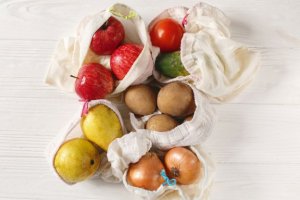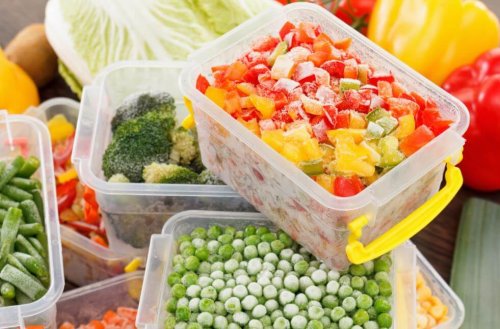How to Carry out Sustainable Nutrition

Sustainable nutrition goes far beyond eating healthily. This model assumes a commitment to the planet and fighting against problems such as pollution. If you’re interested in this way of nourishment, we’ll tell you the steps you must follow.
Five steps to carry out sustainable nutrition
1. Sustainable nutrition: don’t buy an excess of food
In Spain, 7.7 million tons of food is thrown away every year. It’s a fact that should embarrass us and make us reflect on the lifestyles we lead.
It happens to us all: we buy too much food that later expires and we have to throw it away. Either we don’t find the time to cook the food we buy or we simply don’t want it anymore.
It’s also common for us to find an offer at the supermarket and end up buying more than we need. In the long run, it’s not cheaper, it’s quite the opposite because we throw away part of the purchase.
In light of this, we should only buy the food we need. Moreover, everyone generally has a supermarket near their home, so there’s no point in accumulating food. If you follow this practice, you’ll also be able to eat fresher meals with healthier properties.

2. Opt for local food for sustainable nutrition
We propose a very simple exercise: open the refrigerator and check the country of origin of several items. You’ll see that most of them traveled thousands of miles to reach the supermarket where you bought them. This is madness, as they can be produced locally and thus, avoid the pollution that transportation causes.
Sustainable nutrition commits to local foods. This not only prevents pollution, but the food also contains more properties because they’re harvested at the exact point of ripening.
Surely, in your city, there’s a nearby vegetable garden where you can buy fruits and vegetables? Many companies can deliver your weekly orders to your home. The taste is much better than the supermarket options too.
3. Freeze the food to make the most out of it
Earlier, we mentioned that it’s common for food to spoil. One way to end this problem is to freeze it. You can do this with both raw and cooked food. You just have to take into account the maximum freezing time and the foods that can’t be frozen.
Carrots are a good example. We use two or three and the rest of the bag ends up in poor condition, which we then throw away. We recommend you peel and dice them. Then, boil and freeze them so you’ll have carrot slices ready to add to any stew.

4. Increase your vegetable consumption for sustainable nutrition
Sustainable nutrition considers vegetables as its main food. This is because, in their growth process, they don’t pollute. In case chemical products are used, they don’t pollute as much as animals do; their waste is highly contaminating.
Additionally, farms pollute soils and water. In fact, several countries have already created a tax aimed at farmers as a result of the CO2 emissions of their animals.
We’re not saying that sustainable nutrition is synonymous to vegan or vegetarian diets. It’s about limiting the consumption of foods of animal origin and prioritizing vegetables.
5. Cook efficiently
Cooking efficiently saves time and money. Doing it is very simple since you just have to follow the sustainable nutrition guidelines. The first thing you have to do is plan your weekly menu. According to the meal plan, you can cook more food at the same time.

If you’re going to bake pasta to make macaroni with tomatoes, you can make more than the usual amount. When you’ve finished cooking, keep some of the leftovers in a container with a few drops of oil. You can use it to make pasta salad for another day.
While you’re cooking the pasta, you can also boil a couple of eggs. Preserve them in the fridge and they’ll be ready to serve with healthy toast for breakfast.
This is just one example of what sustainable nutrition suggests. This same idea can be implemented with baked vegetables that you can use as a garnish or for stuffed fajitas. The same goes for sofrito, which can accompany rice, meat, or fish, or used to make a croquette dough.
Sustainable nutrition goes far beyond eating healthily. This model assumes a commitment to the planet and fighting against problems such as pollution. If you’re interested in this way of nourishment, we’ll tell you the steps you must follow.
Five steps to carry out sustainable nutrition
1. Sustainable nutrition: don’t buy an excess of food
In Spain, 7.7 million tons of food is thrown away every year. It’s a fact that should embarrass us and make us reflect on the lifestyles we lead.
It happens to us all: we buy too much food that later expires and we have to throw it away. Either we don’t find the time to cook the food we buy or we simply don’t want it anymore.
It’s also common for us to find an offer at the supermarket and end up buying more than we need. In the long run, it’s not cheaper, it’s quite the opposite because we throw away part of the purchase.
In light of this, we should only buy the food we need. Moreover, everyone generally has a supermarket near their home, so there’s no point in accumulating food. If you follow this practice, you’ll also be able to eat fresher meals with healthier properties.

2. Opt for local food for sustainable nutrition
We propose a very simple exercise: open the refrigerator and check the country of origin of several items. You’ll see that most of them traveled thousands of miles to reach the supermarket where you bought them. This is madness, as they can be produced locally and thus, avoid the pollution that transportation causes.
Sustainable nutrition commits to local foods. This not only prevents pollution, but the food also contains more properties because they’re harvested at the exact point of ripening.
Surely, in your city, there’s a nearby vegetable garden where you can buy fruits and vegetables? Many companies can deliver your weekly orders to your home. The taste is much better than the supermarket options too.
3. Freeze the food to make the most out of it
Earlier, we mentioned that it’s common for food to spoil. One way to end this problem is to freeze it. You can do this with both raw and cooked food. You just have to take into account the maximum freezing time and the foods that can’t be frozen.
Carrots are a good example. We use two or three and the rest of the bag ends up in poor condition, which we then throw away. We recommend you peel and dice them. Then, boil and freeze them so you’ll have carrot slices ready to add to any stew.

4. Increase your vegetable consumption for sustainable nutrition
Sustainable nutrition considers vegetables as its main food. This is because, in their growth process, they don’t pollute. In case chemical products are used, they don’t pollute as much as animals do; their waste is highly contaminating.
Additionally, farms pollute soils and water. In fact, several countries have already created a tax aimed at farmers as a result of the CO2 emissions of their animals.
We’re not saying that sustainable nutrition is synonymous to vegan or vegetarian diets. It’s about limiting the consumption of foods of animal origin and prioritizing vegetables.
5. Cook efficiently
Cooking efficiently saves time and money. Doing it is very simple since you just have to follow the sustainable nutrition guidelines. The first thing you have to do is plan your weekly menu. According to the meal plan, you can cook more food at the same time.

If you’re going to bake pasta to make macaroni with tomatoes, you can make more than the usual amount. When you’ve finished cooking, keep some of the leftovers in a container with a few drops of oil. You can use it to make pasta salad for another day.
While you’re cooking the pasta, you can also boil a couple of eggs. Preserve them in the fridge and they’ll be ready to serve with healthy toast for breakfast.
This is just one example of what sustainable nutrition suggests. This same idea can be implemented with baked vegetables that you can use as a garnish or for stuffed fajitas. The same goes for sofrito, which can accompany rice, meat, or fish, or used to make a croquette dough.
All cited sources were thoroughly reviewed by our team to ensure their quality, reliability, currency, and validity. The bibliography of this article was considered reliable and of academic or scientific accuracy.
- Carlos Guillén, F. (2004). Educación, medio ambiente y desarrollo sostenible*. Revista Biocenosis.
This text is provided for informational purposes only and does not replace consultation with a professional. If in doubt, consult your specialist.








